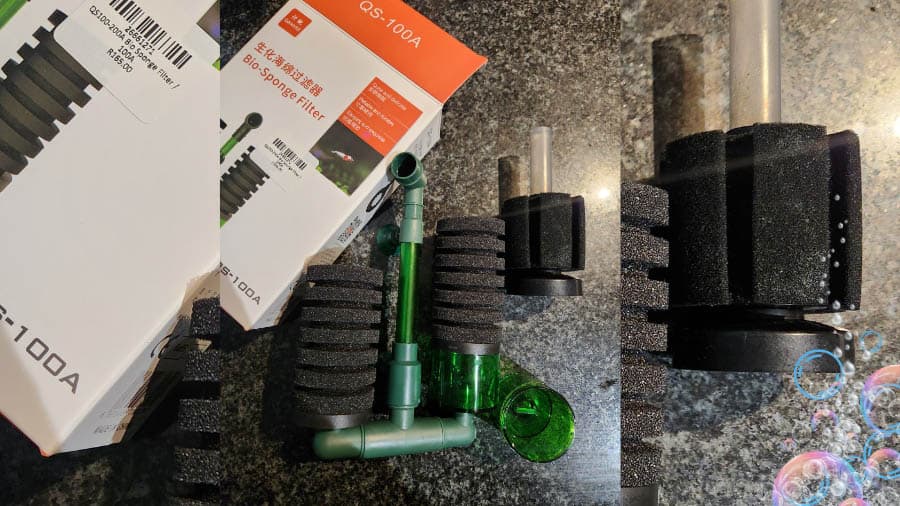Are Sponge Filters Good For An Aquarium?
First, let’s look at what a sponge filter is. An aquarium sponge filter for your fish tank consists of a cylinder-shaped sponge and a weight at the bottom to submerge it. This type of filter also provides additional surface agitation.
Sponge filters provide your aquarium with mechanical and biological filtration. Mechanical filtration occurs when the sponge collects debris in the water, and biological filtration consists of the good bacteria that the sponge filter brings to the tank.
Sponge filters are highly underrated and excellent for your fish tank. They have benefits and drawbacks, but in my opinion, there are way more benefits. Below, I will walk you through all the various advantages and disadvantages to consider if you are contemplating a sponge filter for your tank.
Understanding the benefits and disadvantages of a sponge filter will help you quickly see how beneficial it is for your aquarium.
What Are The Benefits Of A Sponge Filter?
Number one would be the beneficial bacteria you get from having a sponge filter. If you aren’t exactly sure why people keep on mentioning why having a beneficial bacteria source is such an advantage, here is why:
- Having an extra used sponge filter available means you can pop it into a new tank, which will immediately be able to handle the bio load of fish to that tank. You don’t have to wait to add fish and cycle a tank. This is especially handy if you need an emergency quarantine or hospital tank for your fish.
- Sponge filters are highly recommended for baby fish or shrimp fry tanks. These sponge filters are incredibly safe for fry, and the small fry is even able to sit and eat from the sponges without getting sucked up as they would have from a regular filter.
The next benefit I have to mention is the price tag. Sponge filters are very cheap and worth your money.
Sponge filters, especially courser sponges, are low-maintenance. As your sponge carries out its mechanical filtering (collecting debris in the water), the more it accumulates, the less effective it will become at filtering. A courser filter sponge will need less regular cleaning as it won’t clog up as fast as a finer sponge. Cleaning is a very quick and easy process.
You can customize your sponge filter by stacking sponges or adding an airstone in the middle for better bubble flow. Stacking your sponges is a great option if you only have one air pump and would like a more extensive filtration without losing more surface area in your tank.
Did I mention that these filters are also mobile in your fish tank?
Sponge filters are great at keeping your aquarium water clear, adding aeration to your tank water, and agitating the surface water, eliminating that oily layer on the water.
Another positive I need to mention is the fact that a sponge filter has no moving parts, meaning it can’t burn out if not running while in water.
If you live in an area or country that experiences power outages, a sponge filter is a great emergency backup filter. The air pump uses minimal power and can be run on a battery for hours.

What Are The Disadvantages Of A Sponge Filter?
Now, let’s discuss the downsides of having a sponge filter. Firstly, the filter is inside your fish tank, taking up space, which is definitely a negative. You can try to hide it with plants, rocks, or other decorative items, but let’s face it, it is not very attractive.
Next, I need to mention that you need an air pump. These air pumps are usually noisy, so it’s best not to have one in your bedroom or where you take naps unless you like the noise. Unfortunately, if you don’t set your sponge filter correctly, it can make large bubbles that will be ineffective and add to the noise level.
As mentioned previously, a sponge filter only provides mechanical and biological filtration, which means chemical filtration isn’t possible, as chemical media cannot be included in this type of filter.
The other negative that I don’t feel is a real negative is that these filters don’t create much flow. I personally think if you require better flow, you need to look at the dual sponge filters. I have a 10-gallon (38 L) Betta tank in which I keep my Betta fry, with a dual sponge filter. It has a flow pipe with which you can change water flow directions.
The flow is perfect for Betta fish, other fish, or invertebrates that don’t like having too much flow but all the filtration.
